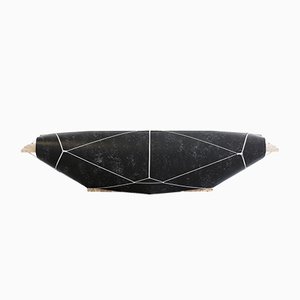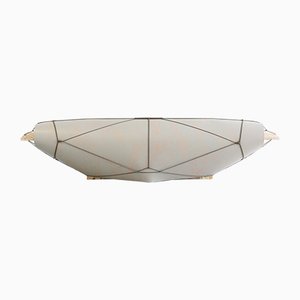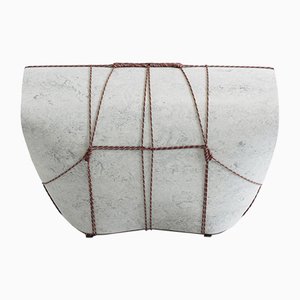Eindhoven-based Studio Kolk & Kusters dares to go deeper
Fragile Beauty
Dreamy, contemplative, heavily researched, fastidiously crafted. The work of Eindhoven-based duo Maarten Kolk and Guus Kusters tends to be quite visually subdued—but it’s never for the faint of heart. Each precious conversation piece they produce asks the viewer to slow down and think more deeply about the world we live in (and the world we may have lost). But such a demanding approach hasn’t hurt the studio one bit. They’re the darlings of a certain loyal segment of the contemporary design cognoscenti, regularly exhibited in highbrow contexts like the Zuiderzeemuseum Enkhuizen, MU Eindhoven, Museum Boijmans van Beuningen Rotterdam, and Design Museum Holon, among others.
Pamono editor Rachel Miller reached out to these quiet up-and-comers to pull back the curtain on their unique process. Read on for highlights from their conversation.
Rachel Miller: How would you describe your overall aesthetic and design philosophy? What principles or inspirations do you keep in mind when designing?
Maarten Kolk & Guus Kusters: We always search for the poetic and fragile beauty that is often overlooked in things. We feel it’s the small things that give something character and soul; which is why we often like to use words like “silence,” “stillness,” “absence,” and “remains.” We like to show an action that has passed and the work that has been done; revealing scars and ephemeral traces. This approach generates a certain intimacy between an object and its owner; it illustrates the object had a past life before making it into the hands of its new owner.
RM: How do your surroundings influence your work?
MK & GK: A lot of our work is inspired by nature. The fragility that we look for in things and feel inspired by is easily found there, since nature doesn’t hide its flaws or strive for excellence in execution. It can be the way a plant is slightly deformed because one side received more sunlight than the other or the way a bird can surf the wind just for fun. Currently, we are trying to search for this in a more abstract way, in the voice of a material or a production technique.
We’ve spent a lot of time in a ceramic work center located in the Netherlands, and we always thought it was quite funny how people feel it’s very hard to control ceramics—they often become very frustrated in trying. We let go; it’s the will of the material that commands a conversation, creating a unique dialog that ultimately reveals its individual character and soul, as it is found in nature.
RM: Who are you designing for?
MK & GK: We often hear that people who buy our objects don’t display them very publicly, but rather place them in their bedroom, on top of their desk, or in another place that’s very private. And we love that! In a world that continues to produce so much new and soulless crap, we’re honored to hear that people tend to build up relationships with the things we make.
RM: How do you approach each design project? What is your process?
MK & GK: A lot of our work is a continuation of something we did before, as we feel it’s naïve to start from scratch each time. Over the years, we have built a library of knowledge and techniques that we continually draw upon with each new project.
We have always considered color to be an important design element—as it can steer an object or a space in a certain direction. The former director of the Rembrandt House Museum noticed our appreciation of color and invited us to create a modern interpretation of Rembrandt’s use of color. We decided to translate fragments of his paintings into ceramics and textiles. We elaborately researched 1,000 different glazes and textile weaves by consulting Rembrandt experts about pigments, mediums, the importance of a brushstroke, painting grounds, and the like. After this project finished at the end of 2016, we felt it would be a pity to not continue working with this library of knowledge and the techniques that we had developed. In addition to translating this knowledge into different designs and approaches, we’re currently working on a Rembrandt color pallet for the exhibition halls of Museum De Lakenhal in Leiden that will display the work of Dutch masters such as Rembrandt alongside modern art.
RM: How would you describe your past projects? Is there a project or a collaboration you are particularly attached to?
MK & GK: While, of course, some things are more personal than others, we feel connected to all the projects we have done. A specific collaboration we appreciate very much is our ongoing relationship with design agent Thomas Eyck. After he was the first buyer of Maarten’s graduation work, we kept in contact with him over the years. In 2013, he commissioned us to design a porcelain tableware set called Withering Tableware where we translated the withering of flowers into tableware designs. After this commission Thomas Eyck adopted several of our projects into his collection, making him our main representative. We feel he understands our passion and motivation very well and treats our work with lots of respect.
RM: Is there a particular thread that ties all of your work together?
MK & GK: I think the thread in our work is the fragile beauty we’re trying to capture and the fact that we design from the heart. We never start designing for an end result, but rather from an urge that we feel we need to dive deeper. I think the fact that we keep things so close to ourselves creates a family of work.
RM: Building on your design knowledge, how do you reinvent conventional forms and materials in your designs?
MK & GK: We feel it’s quite important to draw from existing forms, classic elements, and references. The idea of “new” doesn’t quite exist. Why not embrace everything that is already there and try to add more value or reposition it?
RM: We missed you at Salone this year, why didn’t you exhibit?
MK & GK: We didn’t show at Milan this year as we’re currently focusing on other projects. Last year we had our first solo show, and since we have a love-hate relationship with Milan we decided to go off the grid and host an invitation-only salon show in a Milanese penthouse. We, as well as our guests, were very happy about the calmness of this presentation and the fact that you could have a real conversation with someone during a hectic event like Salone del Mobile. We’re considering doing this again next year.
RM: What is next for Studio Maarten Kolk & Guus Kusters?
MK & GK: We are really excited for our next venture in contemporary tattooing. After being interested in the concept of tattooing for years, but not being able to find the style we were looking for, we decided to start a studio ourselves called Silent Mark Studio. As the current tattoo industry is heavily based on tradition and expression, we believe that there is a lot of potential in the craft itself that is often overlooked. As our work is already about looking and listening to materials and crafts and blending this into new objects, we thought, why not work on the most personal canvas man carries with them, the skin. Currently, we’re working on our first collection of tattoos and are excited to announce that the studio will open September 1st in Eindhoven.
-
Text by
-
Rachel Miller
Rachel is a California native whose passion for travel has led her on some pretty crazy adventures around the world. After living in Korea for three years, she decided on a whim to move to Germany. While she still has a wandering soul, Berlin has captured her heart, and she's decided to make this multicultural hub her permanent home. Most of her free time is spent playing beach volleyball, exploring the city's many arty scenes, and hunting down Berlin's best craft beer.
-





